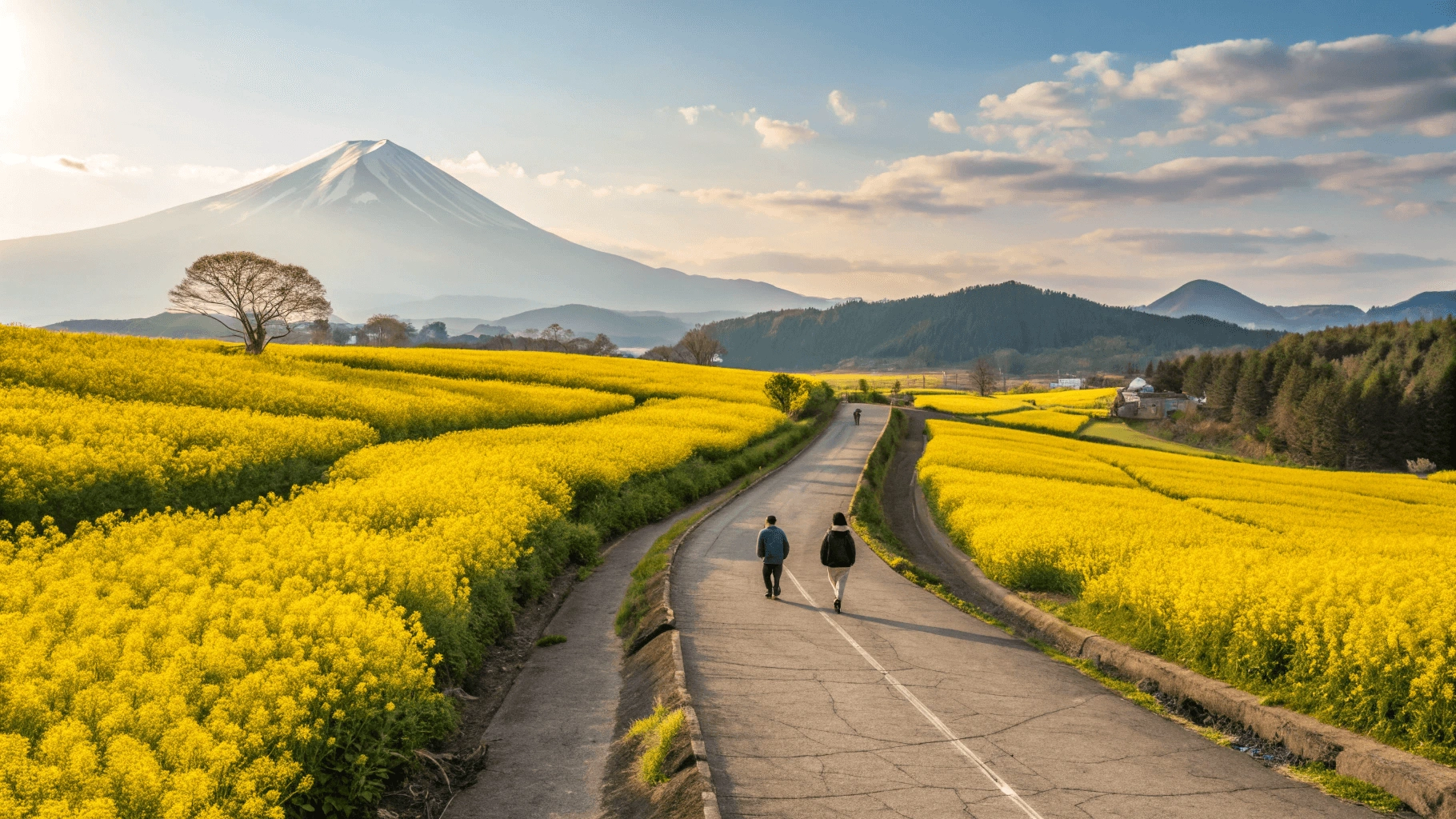Introduction: The Magic of yellow spring road japan
As winter’s chill gives way to spring warmth across Japan, something magical happens. Countless roads and pathways transform into stunning ribbons of yellow, creating breathtaking natural corridors that seem to glow under the spring sunshine. These vibrant yellow paths weaving through the Japanese countryside have captured the imagination of travelers worldwide.
If you’ve been searching for information about “Yellow Spring Road Japan,” you should know that this isn’t actually the official name of one specific location. Rather, it’s a descriptive term that refers to several iconic spots across Japan where spring brings spectacular displays of yellow blooms along roads and pathways. In this guide, I’ll take you through the most likely candidates for what people call “yellow spring road japan” and provide you with all the information you need to plan your perfect spring visit.
Table of Contents
What Exactly Is a yellow spring road japan?
The term “yellow spring road japan” likely originated as a descriptive phrase for any road or path in Japan lined with vibrant yellow flowers during the spring season. While not an official designation, it perfectly captures the essence of these stunning seasonal attractions.
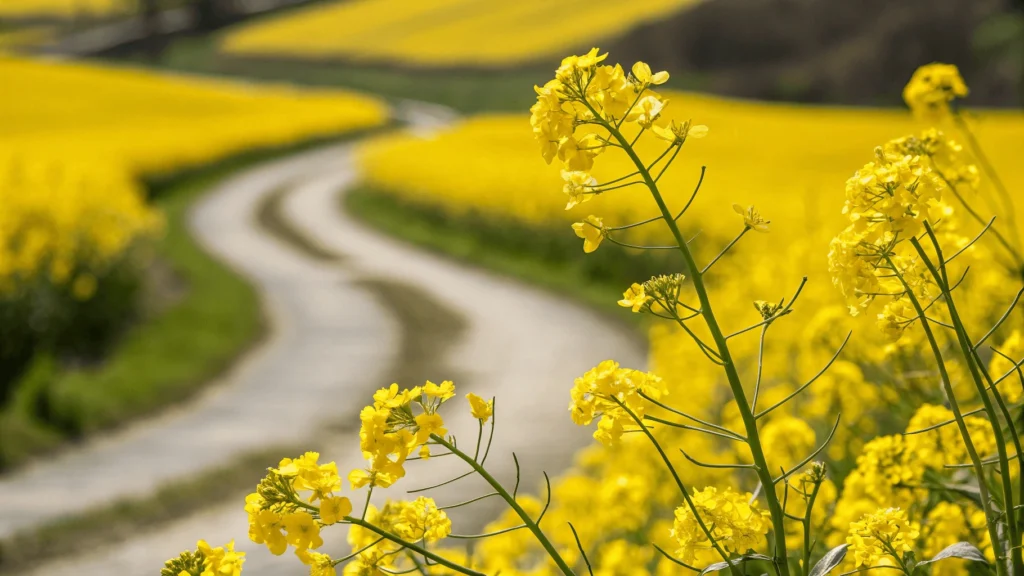
Several types of flowers create these yellow spectacles across Japan:
- Rapeseed (Nanohana): The most common flower creating yellow roads in spring, with bright yellow blooms covering fields and lining pathways from February through April.
- Sunflowers (Himawari): Though primarily summer bloomers (July-August), some varieties and locations may feature early blooms in late spring.
- Forsythia: These bright yellow shrubs line some pathways and bloom in early spring.
- Mimosa: In certain regions, these fluffy yellow flowers create golden pathways in early spring. For more details on the seasonal bloom of nanohana and other spring flowers, visit the Japan Meteorological Corporation’s Flower Forecast page for updates across the country.
Let’s explore the top locations that might be what travelers are referring to when they search for “Yellow Spring Road Japan.”
Top Contender #1: Nanabatake Road: Chiba’s Famous “yellow spring road japan”
Nanabatake Road: Chiba’s Famous “yellow spring road japan”?
When people talk about a “yellow spring road japan” in Japan, they’re most likely referring to the spectacular Nanabatake Road in Chiba Prefecture. This scenic route offers one of the most impressive displays of yellow rapeseed flowers in the country, creating a golden corridor that attracts visitors from across Japan and beyond. The official Minamiboso tourism website provides up-to-date information on flower events and local attractions
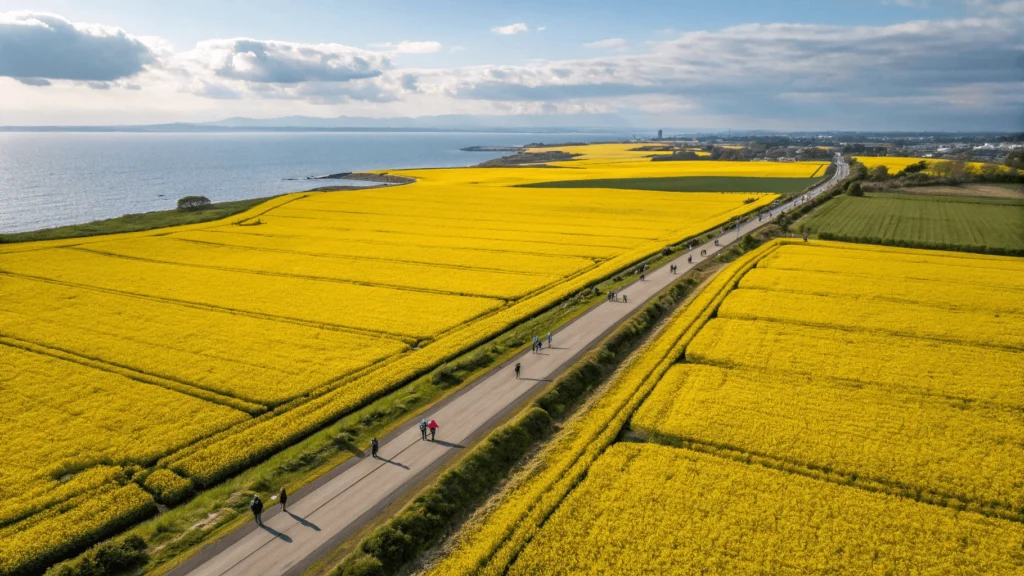
What Makes Nanabatake Road Special
Nanabatake Road features expansive fields of rapeseed (canola) flowers that bloom in vibrant yellow during early spring. The road passes through these fields, creating the perfect embodiment of a “yellow spring road japan” – a pathway literally flanked by golden blooms as far as the eye can see.
Location Details
| Location Information | Details |
|---|---|
| Prefecture | Chiba |
| Specific Area | Minamiboso City |
| Nearby Landmarks | Tateyama Castle, Chikura Beach |
| Map Coordinates | 35.1213° N, 139.8350° E (approximate) |
Best Time to Visit
The peak bloom period for Nanabatake Road typically falls between mid-February and late March, making it one of the earliest spring flower displays in the Tokyo area. The flowers are usually at their most vibrant in early March, but this can vary slightly depending on that year’s weather patterns. The Japan Weather Association offers seasonal bloom forecasts to help visitors plan their timing accurately
“The rapeseed flowers along Nanabatake Road create a golden sea that seems to stretch infinitely. It’s one of those rare places where photographs simply can’t capture the overwhelming beauty of seeing it in person.” – Local tour guide
How to Get There
By Train:
- Take the JR Uchibo Line to Awa-Katsuyama Station
- From there, you can either:
- Take a local bus to Nanabatake Road (approximately 15 minutes)
- Hire a taxi (approximately 10 minutes)
By Car:
- From Tokyo, take the Tokyo-Wan Aqua-Line and Tateyama Expressway
- Follow signs to Minamiboso
- Parking is available at designated areas near the fields (¥500 for the day)
What to Expect
Visitors to Nanabatake Road can enjoy:
- A walking path approximately 1.5 kilometers long
- Panoramic views perfect for photography
- Small local food stalls selling regional specialties during peak season
- The nearby Flower Center with additional gardens and facilities
- Several photo spots with designated frames and viewpoints
For the most current information about Nanabatake Road, visit the Chiba Tourism Website (link would be included in the actual post).
Top Contender #2: Sunflower Fields – A Summer Alternative
Could “yellow spring road japan” Mean Sunflower Paths? Exploring Options
Some travelers searching for “Yellow Spring Road Japan” may be looking for the equally impressive sunflower fields that create yellow pathways across the country. However, it’s important to note that sunflowers typically bloom in summer rather than spring.

Clarifying the Seasonal Difference
While rapeseed creates yellow roads in spring (February-April), sunflowers generally bloom from July to August. There are very few varieties that bloom earlier, though some regions with milder climates might see blooms in late spring.
Famous Sunflower Locations
If you’re interested in experiencing Japan’s “yellow roads” during summer instead, consider these famous sunflower destinations:
- Hokuryu Town, Hokkaido
- Features over 1.5 million sunflowers across 23 hectares
- Peak bloom: Late July to mid-August
- Known as “Himawari no Sato” (Sunflower Village)
- Creates stunning yellow corridors that stretch toward the horizon
- Akeno Sunflower Field, Yamanashi Prefecture
- Offers 600,000 sunflowers with stunning mountain backdrops
- Peak bloom: Mid-July to early August
- Features designated walking paths through the flowers
- Located about 2 hours from Tokyo For visiting details and directions to Akeno’s sunflower field, check the Yamanashi Tourism Organization’s page on sunflower viewing spots.
For visitors determined to see yellow flowers in spring rather than summer, rapeseed fields like Nanabatake Road remain the best option.
Other Potential yellow spring road japan
Beyond the Famous: Other Yellow Spring Flower Spots in Japan
While Nanabatake Road might be the most famous “yellow spring road japan,” several other locations across Japan offer similar experiences:
Azumayama Park (Shounan, Kanagawa)
- Features rapeseed flowers blooming along hillside paths
- Offers views of Mt. Fuji on clear days
- Peak bloom: Mid-March to early April
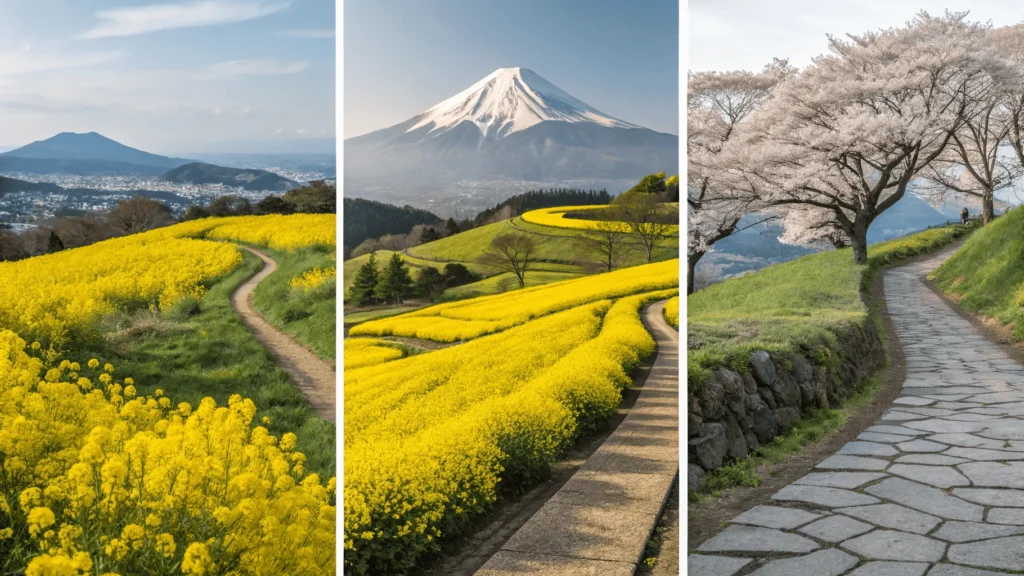
Awaji Island (Hyogo Prefecture)
- The Awaji Hanasajiki flower park offers stunning yellow rapeseed fields
- Walking paths wind through the blooms
- Peak bloom: February to April
Mimosa Roads in Kawazu (Shizuoka)
- The Kawazu area features some paths lined with yellow mimosa trees
- Combined with the famous Kawazu cherry blossoms for a pink and yellow spring display
- Peak bloom: February to early March
Planning Your Visit to Any Yellow Flower Destination
Essential Tips for Visiting Japan’s Yellow Flower Roads
No matter which “yellow spring road japan” you choose to visit, these practical tips will help make your experience more enjoyable:
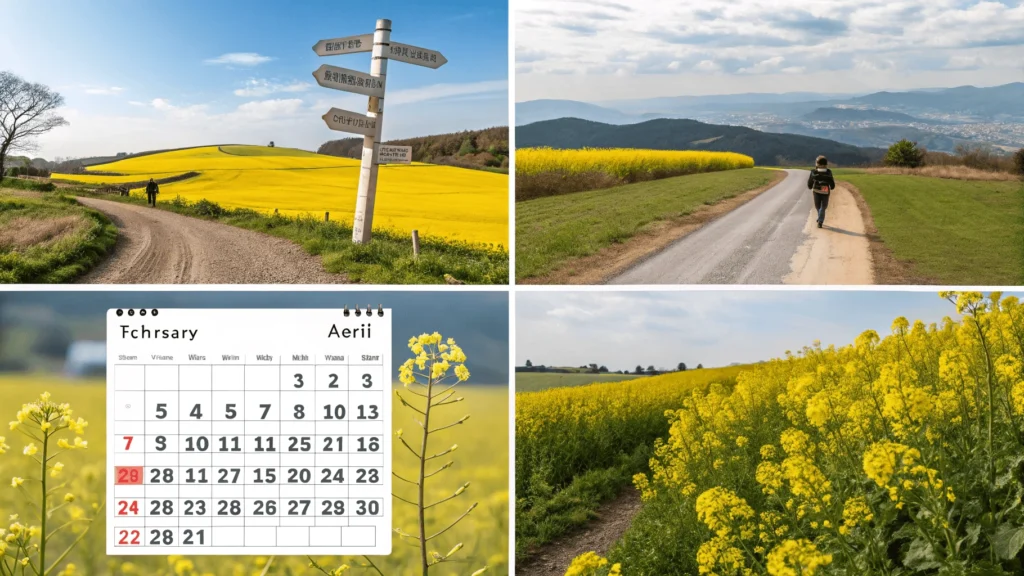
Best Season Timing
- For rapeseed (spring): February to April
- For sunflowers (summer): July to August
- Always check local tourism websites for bloom forecasts before visiting
- Weekday visits will help you avoid crowds
Transportation Tips
- Consider purchasing a JR Pass if visiting multiple regions
- Rental cars provide the most flexibility for reaching rural flower spots
- Many flower destinations offer special shuttle buses during peak season
- Download transportation apps like Japan Transit Planner before your trip
What to Wear
- Comfortable walking shoes suitable for unpaved paths
- Layered clothing (spring temperatures can vary significantly)
- Hat and sunscreen (flower fields typically have little shade)
- Allergy medication if you’re sensitive to pollen
Visitor Etiquette
- Stay on designated paths
- Don’t pick or damage flowers
- Ask permission before photographing local farmers or private property
- Follow any drone regulations (many flower fields restrict drone usage)
Photography Tips
- Visit during “golden hour” (early morning or late afternoon) for the best light
- Bring a wide-angle lens to capture the expansive fields
- Consider a polarizing filter to enhance the yellow colors against blue skies
- Look for unique perspectives (low angles, focusing on individual flowers with fields in background)
Conclusion
The “yellow spring road japan” of Japan isn’t a single location but rather a phenomenon that occurs across the country when spring brings spectacular yellow blooms to various regions. Whether you choose to visit the rapeseed-lined Nanabatake Road in Chiba, wait for summer’s sunflower displays in Hokkaido, or discover one of the lesser-known yellow flower paths, you’re in for a visual treat that exemplifies Japan’s extraordinary seasonal beauty.
The combination of perfectly maintained paths, meticulously cultivated flowers, and Japan’s stunning landscapes creates an experience that draws photographers and nature lovers from around the world. These golden corridors represent Japan’s remarkable ability to showcase and celebrate the changing seasons in ways that feel both natural and artfully composed.
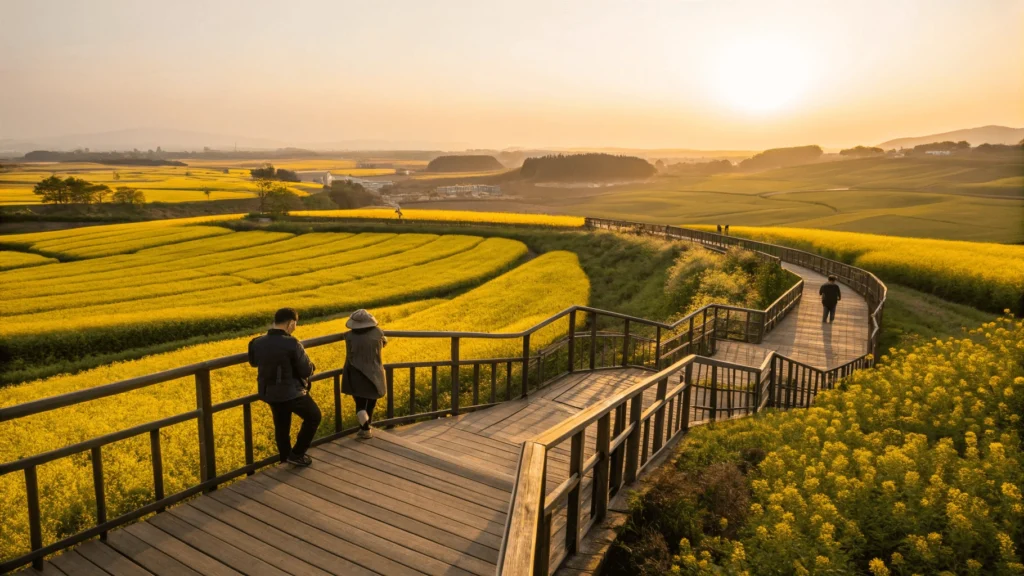
Learn more about Japan’s seasonal tourism highlights through the Japan National Tourism Organization (JNTO).
Have you visited any of these yellow flower roads in Japan? Which one is your favorite, or which would you most like to experience? Share your thoughts and experiences in the comments below!
Frequently Asked Questions
What is the Yyellow spring road japan?
“yellow spring road japan” isn’t an official name but rather describes several locations in Japan where roads are lined with yellow flowers during spring. The most famous example is likely Nanabatake Road in Chiba Prefecture, where rapeseed flowers create stunning golden corridors from February to April.
Where is Nanabatake Road located?
Nanabatake Road is located in Minamiboso City in Chiba Prefecture, approximately 100 kilometers southeast of Tokyo. The nearest train station is Awa-Katsuyama on the JR Uchibo Line.
When is the best time to see yellow flowers in Japan?
For rapeseed/nanohana (the most common spring yellow flowers), the best time is February to April, with peak bloom typically occurring in March. For sunflowers, which create similar yellow landscapes, the peak season is July to August.
What flowers make the roads yellow in spring in Japan?
The primary flower creating yellow roads in spring is rapeseed (nanohana), which blooms in bright yellow clusters from February through April. In some areas, forsythia shrubs and mimosa trees also create yellow pathways during early spring.
Are there entrance fees for visiting these yellow flower roads?
Most rapeseed fields and flower roads are free to visit, though some may charge for parking (typically ¥500-¥1000). More developed tourist attractions like flower parks might charge entrance fees ranging from ¥300-¥1000 per person.
How do I avoid crowds when visiting Japan’s flower roads?
To avoid crowds, visit on weekdays rather than weekends, arrive early in the morning (before 9 AM), or plan your visit for slightly before or after peak bloom when the flowers are still beautiful but crowds are thinner.

